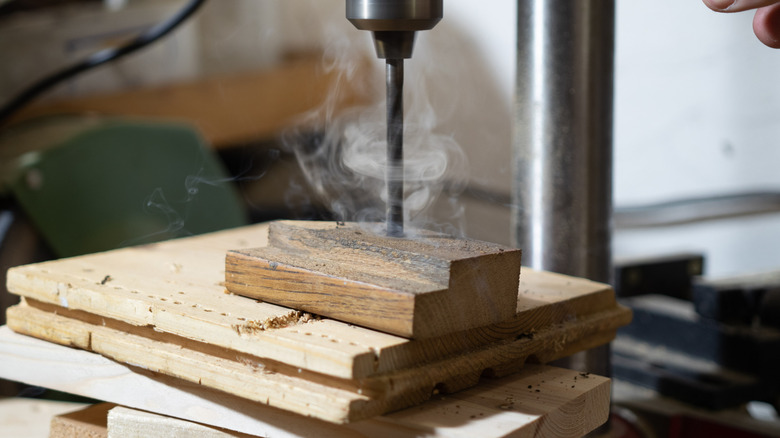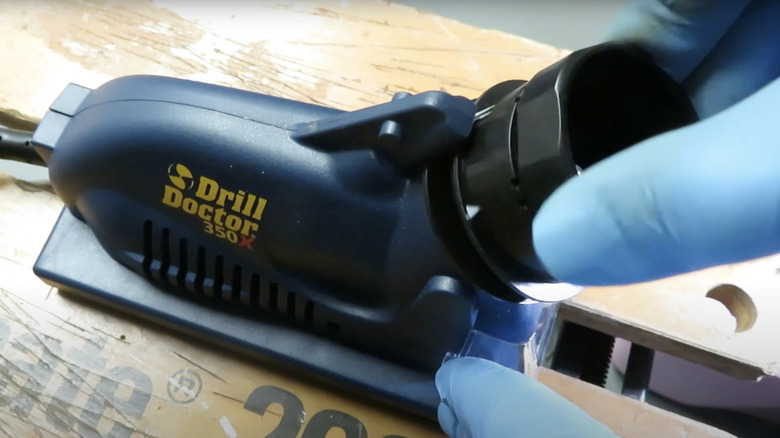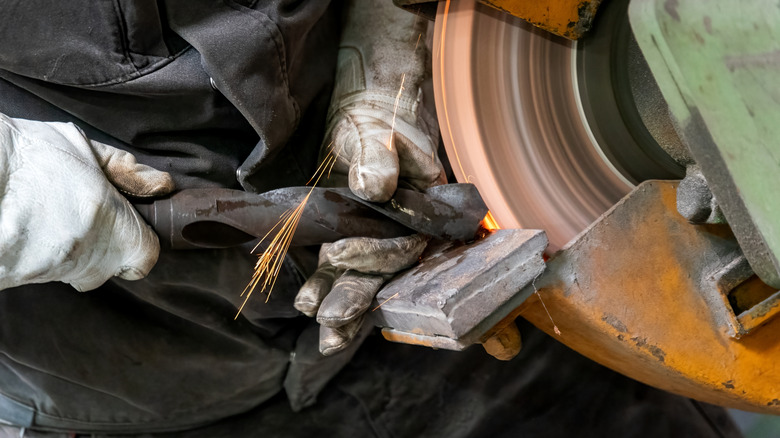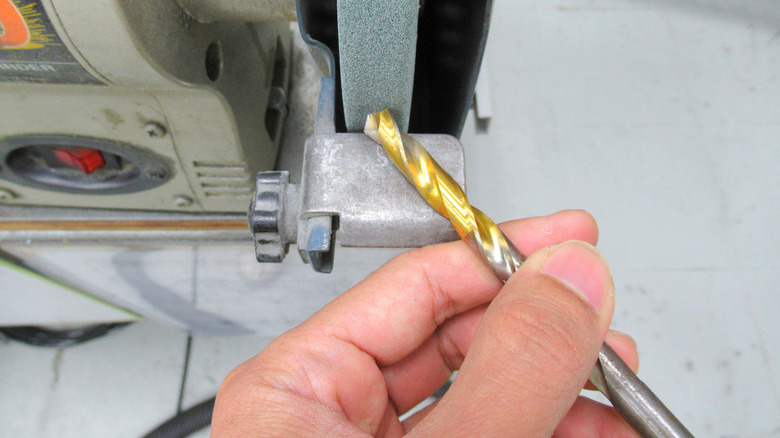The Best Method For Sharpening Dull Drill Bits To Bring Them Back To Life
We may receive a commission on purchases made from links.
You can tell a dull drill bit more or less immediately. If you're drilling wood, you'll likely see thin wisps of smoke as it starts to burn. With masonry or metal, you'll get a lot of noise but hardly make a dent. The clever hack for drilling tile without cracking it won't work with a dull bit either. Fortunately, bringing your drill bits back to life takes minimal effort.
Drill bits can be sharpened by hand or with a bench grinder, but the best method is using a dedicated drill sharpener machine like the Darex or the Drill Doctor 350X. These machines are simple to use yet very precise. The drill bit drops into a clamp that presents it to the internal grinding wheel at the perfect angle. A preset amount of material is automatically removed; just follow the correct safety precautions and make sure the bits are suitable for sharpening, and this type of machine will get the job done in moments.
A bench grinder is a popular choice because it can also be used to sharpen your lawn mower blades, garden shears, and chisels. However, many find bench grinders intimidating, with wheels spinning at several thousand rpm; you must be extra careful and keep fingers clear as there are no guards. Ryobi sells a reasonable one at Home Depot; more powerful options can set you back a few hundred to over $1,000. If you're on a budget, sharpening drill bits by hand is also an option. All you need is a vise and a flat file, like this SI FANG Diamond-Coated File. Give the upper faces four or five light strokes with the file, maintaining the existing tip angle. If you must sharpen a specialty drill bit, you'll have to use an angle grinder or a whetstone.
How to sharpen dull drill bits with a dedicated shapening device
If you're using a machine like the Drill Doctor to sharpen bits, the procedure boils down to two steps: aligning the bit then sharpening it. While the process is simple enough, there are a few details to wrap your head around before starting. First, learn the parts of the sharpener. Some models, like the Drill Doctor 750X, have two ports: one for alignment and one for sharpening. Others, like the more compact 350X, let you to breeze through both steps using a single port. You'll also notice that the these machines come with a chuck; this part holds the bits in place during both steps.
To align the bit, insert it into the chuck until ½ an inch of it protrudes from the jaws. Tighten the chuck a little and line up the leading edge of the flute with the fingers. Now, insert the chuck into the alignment port; the triangle marking on the chuck should align with the cam guide on top of the port. Push the chuck all the way in and tighten its knob — the bit should be fixed in place at this point.
Next, turn on the sharpener, insert the chuck with the drill bit into the sharpening port, press it down until the bit contacts the spinning wheel, and rotate it halfway clockwise. Repeat the half-turn six times for bits measuring a ¼ inch or less, and up 20 times for bits for larger bits. If the chuck doesn't have markings to help measure the turns, make your own with a sharpie. Other dedicated drill sharpeners, like those made by Drill Doctor's parent company Darex, work in a similar manner.
Safety and other tips for sharpening drill bits for the first time
If you're opting to sharpen drill bits with the Drill Doctor or a similar device, you may feel that safety precautions are unnecessary — after all, the sharpening wheel is safely housed inside the mechanism. But even so, the Drill Doctor manual (via the Naval Postgraduate School) lists a number of safety instructions one should follow when operating the device. For one, don't temper with the guards and insepct the machine for damaged parts before every use. If you're using an extension cord, make sure it has sufficient amperage for the tool. When operating the sharpener, never force it if you feel that it's not working fast enough and don't stick your hands into the sharpening or alignment ports. If you've opted to use a bench grinder, make sure it's firmly affixed to the workbench before you turn it on.
Safety glasses are a must when you sharpen drill bits, whether you do so with the Drill Doctor, another device that has an enclosed wheel, a bench grinder, or a even a file. Each of these methods can send metal debris flying at high speeds. Likewise, protect your hands from accidental contact with the sharpening tool by wearing sturdy gloves.
If the tool you're using doesn't automatically ensure proper alignment — like a bench grinder or a file — you'll have to take care to maintain the angle of the cutting edge. You'll only need to shave off a small bit of metal to make the bit sharp. To help you see that you've removed a small layer of metal, use a sharpie to color the bit's bevel, before you start sharpening; this hack works for any sharpening technique, whether you're armed with a file or the Drill Doctor.
Before you start sharpening it helps to know the drill bit material
Not all drill bits respond to sharpening the same way; for some, replacement may be a better route. If you've ever had to choose the right drill bit, you may have noticed that several different materials are used. High-speed steel (HSS) is found in most standard twist drills used on wood, metal, and plastic, whereas cobalt is typically used for harder materials like cast iron or stainless steel. Tungsten-carbide tipped (TCT) and titanium nitride coated (TiN) drill bits are also popular.
HSS is hard-wearing, but other materials can be added to make these drill bits harder and longer lasting. This has an impact on how they are sharpened or whether it is even possible. HSS and cobalt drill bits can be sharpened with a standard metal file or grinding wheel. TCT drill bits need either a file encrusted with industrial diamonds or a diamond grinding wheel, like the ones that come with Drill Doctor sharpeners. Don't worry, they're not as expensive as they sound!
However, the material itself is not the only challenge. Construction is also important. HSS and cobalt drill bits are the same all the way through. They can be sharpened multiple times until they are too short to use. TCT drill bits, as the name suggests, have a hardened tip. This wears away each time it is sharpened. After three or four attempts, there will be nothing left so a replacement will be needed. Sharpening TiN drill bits is also difficult because the coating is thin. If they lose this coating, they are made of HSS underneath. Take this into consideration when working with different types of bits and avoid making these drill bit sharpening mistakes when you get to work.



